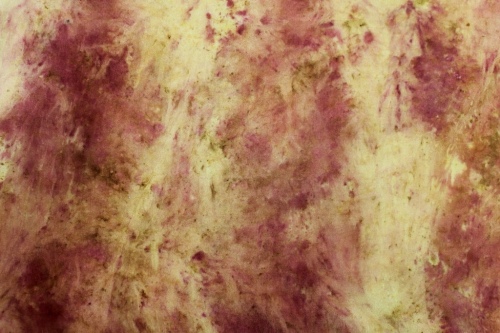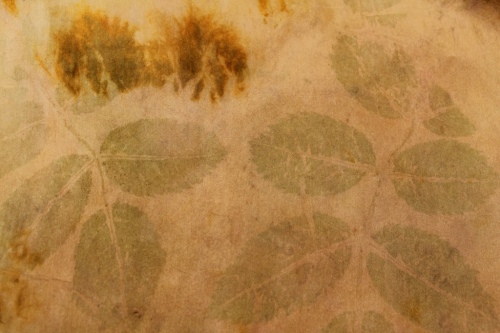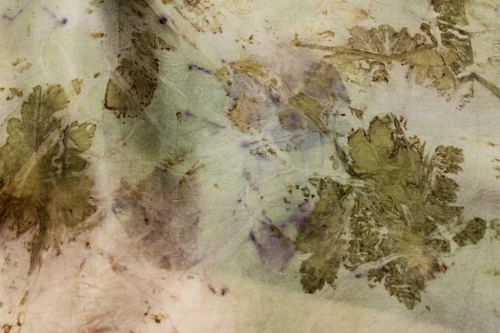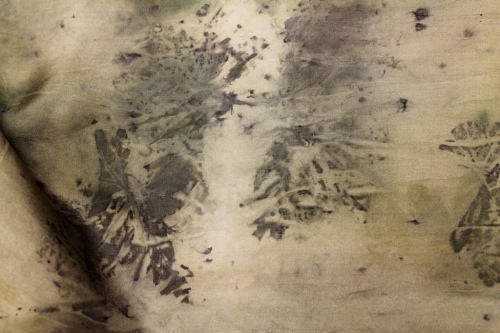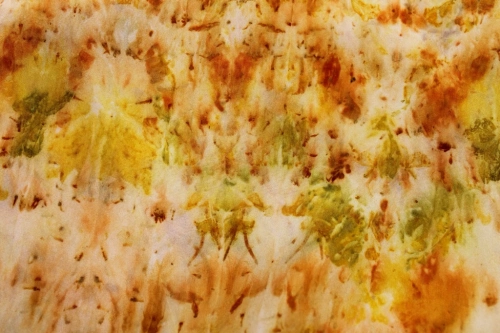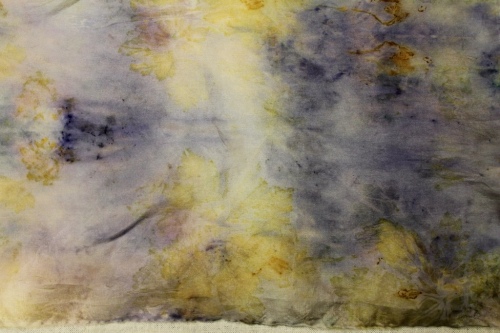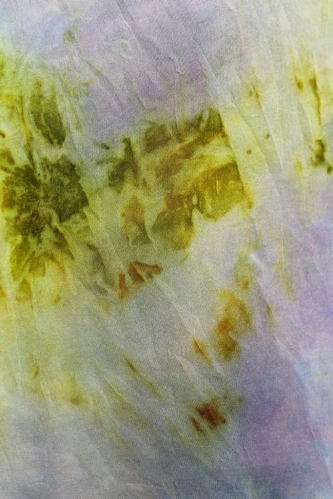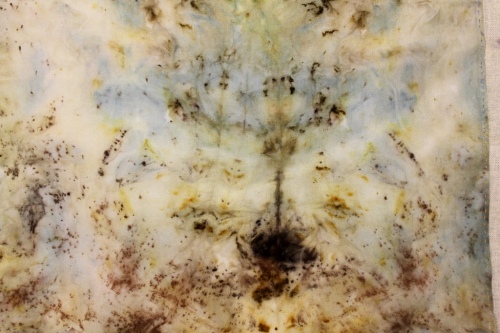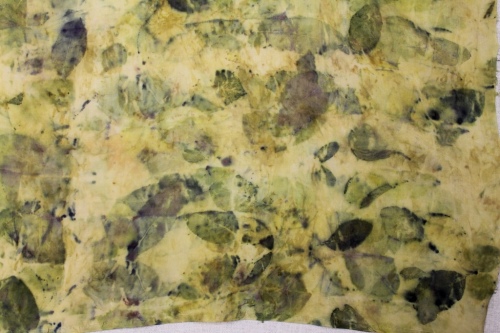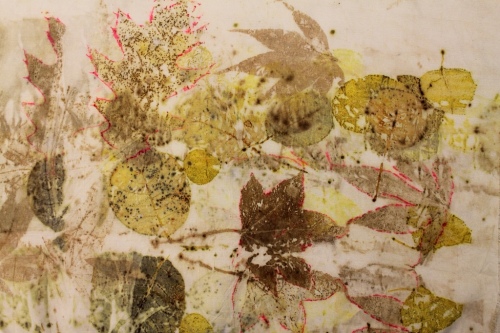Eco dyeing and eco printing are, for me, art forms sprung from my lifelong love of plants and gardening. My earliest childhood memories, in fact, are of the textures, forms and colours of plants – bilberries, heather and fuschia growing in Orkney. Since then, I have made a garden in every place I have lived, starting small in England with seed packages of orange calendula, blue cornflowers and purple Virginian stock that my garden-loving parents gave me. In my current Ottawa garden, just two summers old, I am slowly building a collection of plants native to eastern Ontario or other parts of North America, but not so exclusive a collection as to banish well-beloved European green immigrants, sentimental favourites, that have adapted to our eco zone. I am also delving into the tradtional use of dye plants by First Nations of this area. Some of the latter plants (Sanguinaria canadensis /bloodroot, for example) had made themselves at home in my new garden years before we bought the house. Such are the plants that I want to use for eco dyes and prints – local, regional, national and a few well-travelled and well- behaved internationals. The epithet “eco” in eco dyeing can mean several things, of course, but first, I use it to refer to my use of plants that are native to my geographical area, especially those I can grow myself or forage with respect in the neighbourhood.
And now into the garden during a hot and humid month of July in Ottawa. What to find in bloom there, full of seasonal colour for printing? Below, a little bouquet of favourite flowers and leaves that work for printing: Clockwise from the left: Bee balm, Japanese maple, Coreopsis verticillata, rose leaf, blue cornflower, calendula, burgundy cornflower Anthemis tinctoria (Dyer's marguerite), Cotinus obovatus (smokebush).
Not only the oft-invoked serendipity and spontanaity but also some deliberation and discrimination went into planning this series of “July Gardenista” prints. Instead of going first for the “dark and stormy” eco print that is the result of putting iron and tannin- rich plants together in the bundle, my goal with this little collection was to pair complementary colours and to promote a range of analagous colours by a careful choice of pigment-bearing plants. I wanted clear, bright summer's day colours , a “painter's palette” .
And after first showing you the “painter's palette” prints I obtained on paper, I have included some of my “dark-and-stormies” : the iron-tannin-indigo prints that develop fast outside on the stones in the heat of a 35 C day!
Here are the ” painter's palette” results.
The plants below were printed on (thrifted) handmade paper, highly textured, most likely some kind of mulberry (kozo).
The cornflowers, calendulas and coreopsis above are still attached to the paper
Orange calendula print and bloom, above.
Blue cornflower print ( Renaissance artists considered this blue to be inferior – or so say some of the art historians like Daniel Thompson) I love that blue-orange opposition!
Cotinus in July – a new colour each month from this plant! Blue with green from cotinus
The pink-purple is Monarda didyma ” Cambridge Scarlet”/ bee balm
A few pages together. The red stems of the coreopsis bring essential structure to the design on tne surface so covered with abstract smudges of colour
Blue pansy, fresh, prints teal-green: a strong shape in a strong colour. Then we have the yellow- purple complements via Anthemis tinctoria and Monarda didyma, amorphous stains
More red- green complements, with interesting strong red lines and loose smudges in contrast. Plus a bit of blue in there. Where did that come from?
A rose leaf (below) offers a soft yellow to complement the also-soft pink-purple of the bee balm. Strident deep orange-reds sing loud with a powerful dark teal green print from a blue pansy, And an emerald cotinus leaf.
The many contrasts of colour, form and value in these prints keep them from being insipid, don't you think?
And now to the “dark-and-stormies” .
To get really dark prints (black, charcoal, blue-black) from leaves, we need to choose tannin-rich leaves like sumac, oak, walnut, geranium and others and process them with iron bits.I do my D and S's in three stages – three, if I dip the thing in indigo for the last stage.
First stage: Bundle the paper and textile/layer with iron and vinegar to get a good iron print; bundle up the iron chunks and slosh on the white vinegar, 5% acetic acid, no exact proportions. Wrapping the iron or layering it flat works well. No need to alum-mordant; but if you do, no matter. Put the textile or paper with iron between heavy black plastic garbage bags, weighted down, and leave in the sun for a day (or even less if it is very hot outside, say over 30 C. Keep checking…) Leave it to print until you are happy with the result, then unwrap and evaluate. You can add more iron, vinegar, tea leaves and leave it for a while longer if you like.
Second stage: For this stage, I layer on leaves, then I steam the bundle to print the leaves. I layer tannin-rich leaves onto the textile or paper, put the iron bits back in, bundle or stack the package in the dye pot, slosh again with vinegar and process (covered) over high steam heat over water for about an hour. The leaves print blue-black if they are tannin-rich. You may get smidges of yellow or green colouration also. Very nice. I suggest using leaves of contrasting size and shape, like the longer pinnate sumac with the smaller palmate geranium. This kind of attention to shape and size of print elements makes for a more interesting surface design. After all, sooner or later, an artist might like to feel they have some control over the essentially- spontaneous exo print process. Serendipity and considered choices make good partners in design.
Third stage for indigo: Either dribble on a diluted indigo solution from pre- reduced crystals and let dry; or skip this stage and dribble the indigo onto the substrate at Stage Two before steaming.
For good info on using pre-reduced indigo, check out Catherine Ellis' fine PDF via Earth Guild.
NB The indigo I am using at the moment is not the “granola” indigo, i.e., the “haute eco” indigo used by “eco-printerati” which comes from real leaves. MIne Is the synthetic variety, alas, the pre-reduced crystals. But rest assured, Dear Reader, for when my potted Indigo indigofera plant grows big enough, I, too, shall aspire to membership in the aforementioned elite company. And you shall be the first to know. ( And I do have my Japanese indigo in the works, too. )
And now some the pics of the the iron/rust, tannin and indigo prints.
Shlomo cut and welded these iron bits:
The bundle was dribbled and blobbed here and there with indigo: iron bits with tannin from tea leaves.
Other iron bits for the bundles/layers/stacks:
Leaves layered on the textile after the first printing with iron and tea leaves only:
Ready for steam processing: Indigo dribble, tannin marks from some ? leaves in the bundle that printed in the heat of the sun: lots of great rust marks.
Rust prints on paper with indigo and tannin-rich tea leaves, dry.
Part of a rust printed textile:
Sumac prints blue-black with iron bits:
Indigo and rust with tannins and leaf prints:
And one last print: Japanese maple and geranium without iron but with indigo. Just the usual eco print process to print the maple and geranium on rice (mulberry) paper, then pre-reduced indigo dribbled on with a bulb baster. The maples printed different colours on rice paper than on linen where ir gave purple and green, And here, different colours from the upper and under side of the leaf.
And that is it for ” July Gardenista” prints, Dear Reader.
We are off to Brooklyn this week for a week to babysit our newest grandbaby! And to give the poor parents a break – little Zev is no sleeper! We may have time for some arty things – the Brooklyn Botanic Garden is nearby…we will not be able to resist a nice walk in the gardens with our little grandson.
Leaving you with one of my faves:
Until August, then.
Wendy


















































